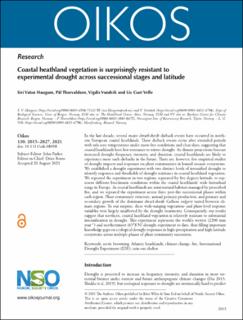| dc.contributor.author | Haugum, Siri Vatsø | |
| dc.contributor.author | Thorvaldsen, Pål | |
| dc.contributor.author | Vandvik, Vigdis | |
| dc.contributor.author | Velle, Liv Guri | |
| dc.date.accessioned | 2022-01-19T12:41:52Z | |
| dc.date.available | 2022-01-19T12:41:52Z | |
| dc.date.created | 2021-10-11T10:31:57Z | |
| dc.date.issued | 2021 | |
| dc.identifier.issn | 0030-1299 | |
| dc.identifier.uri | https://hdl.handle.net/11250/2838268 | |
| dc.description.abstract | In the last decade, several major dwarf-shrub dieback events have occurred in northern European coastal heathlands. These dieback events occur after extended periods with sub-zero temperatures under snow-free conditions and clear skies, suggesting that coastal heathlands have low resistance to winter drought. As climate projections forecast increased drought frequency, intensity, and duration, coastal heathlands are likely to experience more such diebacks in the future. There are, however, few empirical studies of drought impacts and responses on plant communities in humid oceanic ecosystems. We established a drought experiment with two distinct levels of intensified drought to identify responses and thresholds of drought resistance in coastal heathland vegetation. We repeated the experiment in two regions, separated by five degrees latitude, to represent different bioclimatic conditions within the coastal heathlands' wide latitudinal range in Europe. As coastal heathlands are semi-natural habitats managed by prescribed fire, and we repeated the experiment across three post-fire successional phases within each region. Plant community structure, annual primary production, and primary and secondary growth of the dominant dwarf-shrub Calluna vulgaris varied between climate regions. To our surprise, these wide-ranging vegetation- and plant-level response variables were largely unaffected by the drought treatments. Consequently, our results suggest that northern, coastal heathland vegetation is relatively resistant to substantial intensification in drought. This experiment represents the world's wettest (2200 mm year−1) and northernmost (65°8'N) drought experiment to date, thus filling important knowledge gaps on ecological drought responses in high-precipitation and high-latitude ecosystems across multiple phases of plant community succession. | en_US |
| dc.language.iso | eng | en_US |
| dc.publisher | Wiley | en_US |
| dc.rights | Navngivelse 4.0 Internasjonal | * |
| dc.rights.uri | http://creativecommons.org/licenses/by/4.0/deed.no | * |
| dc.title | Coastal heathland vegetation is surprisingly resistant to experimental drought across successional stages and latitude | en_US |
| dc.type | Journal article | en_US |
| dc.type | Peer reviewed | en_US |
| dc.description.version | publishedVersion | en_US |
| dc.rights.holder | Copyright 2021 The Author(s) | en_US |
| cristin.ispublished | true | |
| cristin.fulltext | original | |
| cristin.qualitycode | 2 | |
| dc.identifier.doi | 10.1111/oik.08098 | |
| dc.identifier.cristin | 1944799 | |
| dc.source.journal | Oikos | en_US |
| dc.source.pagenumber | 2015-2027 | en_US |
| dc.relation.project | Norges forskningsråd: 274831 | en_US |
| dc.relation.project | Norges forskningsråd: 255090 | en_US |
| dc.identifier.citation | Oikos. 2021, 130 (11), 2015-2027. | en_US |
| dc.source.volume | 130 | en_US |
| dc.source.issue | 11 | en_US |

